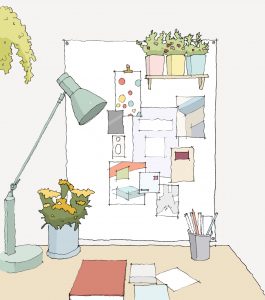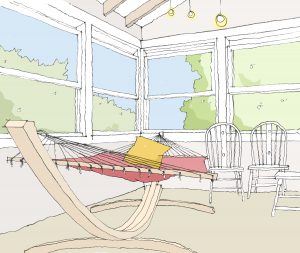We must take the lead on designing for mental health, writes Ben Channon, senior architect at Assael Architecture and author of Happy by Design: A Guide to Architecture and Mental Wellbeing
 Within the last year or so, mental health has been firmly placed front and centre of the media and, by extension, public debate.
Within the last year or so, mental health has been firmly placed front and centre of the media and, by extension, public debate.
Princes William and Harry have been championing the issue through their Heads Together campaign, and a recent government report has revealed that mental ill-health is costing Britain an estimated £99bn a year, with over 300,000 leaving their jobs annually as a result of struggles with their mental health. Globally, the cost of unfettered mental health problems and their related effects is estimated at a whopping £1.6 trillion per year.
Yet despite the overwhelming evidence on the size and severity of mental health issues in Britain and beyond, it is still a topic that is largely overlooked within the world of architecture and planning. Given the overwhelming evidence of the severity of the problem, this is totally nonsensical.
While there are regulations on a huge range of factors, such as sustainability, safety and accessibility, there is no official guidance on how buildings affect our mental health. And the fact that we spend between 80% and 90% of our time inside buildings makes the need to consider mental health implications even more pressing.
Mental health is a topic that is likely to have touched us all in some way. The charity Mind estimates that one in four people experience a problem with their mental health each year. Personally speaking, I too struggled with my mental health during my final years of studying for my architecture degree after years of thinking that it “could never happen to me”. Problems with mental health can affect everyone and anyone – regardless of class, background or ethnicity – and should be an issue we are all looking to improve.
Through advances in neuroscience and scientific research, we can now prove that buildings affect how we feel and how we act. For instance, brain scans show that when people are confronted with spaces that are cluttered, messy or disorderly, they are more likely to have a higher concentration of cortisol, the stress hormone. At the other end of the spectrum, we know that bringing plants and nature inside buildings can have a positive effect on eating and sleeping patterns, as well as improving an individual’s sense of self-worth.
Developing alongside the advances in science and research, is mass urbanisation. The last century has seen a dramatic shift in the way human society organises itself, with more people living in cities today than at any other point in human history. In 2015, the International Organisation for Migration estimated that around 3m people are moving to cities every week. One major consequence of mass urbanisation is that we now spend the vast majority of our waking hours indoors. Without us knowing it, the buildings we live and work in are changing how we feel, in either a positive or negative way.
Despite the continued development of the two trends outlined above, the design and delivery of the built environment has been sluggish to respond and, in some cases, simply apathetic. Time and time again throughout my career, I have been repeatedly shocked to discover how little this important and perennial issue has been explored by those who create and manage the buildings we live and work in.
Once this shock dissipated into frustration, I began researching it for myself, which is how Happy by Design was created – borne from a desire to challenge the status quo and change the way we design our buildings. The book itself takes a no-nonsense approach. It explains how buildings affect our mood and sets out exactly why good quality design is so important for our mental health.
During the writing process, I discovered the multitude of ways in which buildings can impact how we feel, from their aesthetics and materials, to the ways in which they encourage sociability or physical activity. Some of the advice set out in the book is already enshrined in planning or building regulations, such as ensuring a good provision of natural light or providing adequate acoustic insulation.

However, many elements of ‘happy design’ are more subjective and harder to regulate, like the impact of visually interesting facades, flexible spaces or tactile materials. This is where I believe architects and planners have a societal responsibility to champion high quality design that engages our senses and goes beyond the minimum requirements and tenants’ basic needs.
What is plain to see is that those people lucky enough to design and shape the built environment – myself included – must start doing more to create places that make people feel happier, safer and more connected with their communities and environment. If we can’t do this then who exactly are we designing and building for? Happy by Design aims to educate and inform but also – and perhaps more importantly – seeks to start a conversation within the architecture, planning and development communities that raises awareness of just how much buildings affect our happiness and, ultimately, inspire action.
Our collective responsibility for improving the quality of architecture and urban design, which is both professional and social, has never been more important amid a housing crisis and a crisis of public health, both mental and physical. Between us all we can start to shape a future where buildings and cities make us healthier and happier.
Happy by Design: A Guide to Architecture and Mental Wellbeing is available from RIBA Bookshops.
 Ben Channon
Ben Channon
Senior Architect
Assael Architecture
Tel: +44 (0)20 7736 7744
Twitter: @AssaelArchitect
LinkedIn: Assael Architecture
Instagram: assaelarchitecture













